
Lemurs are wet-nosed primates of the superfamily Lemuroidea, divided into 8 families and consisting of 15 genera and around 100 existing species. They are endemic to the island of Madagascar. Most existing lemurs are small, have a pointed snout, large eyes, and a long tail. They chiefly live in trees and are active at night.
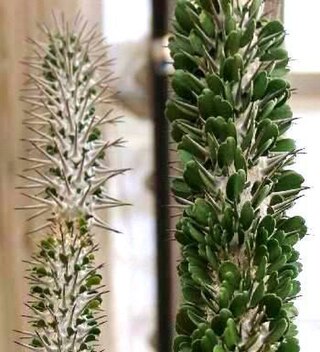
Didiereaceae is a family of flowering plants found in continental Africa and Madagascar. It contains 20 species classified in three subfamilies and six genera. Species of the family are succulent plants, growing in sub-arid to arid habitats. Several are known as ornamental plants in specialist succulent collections. The subfamily Didiereoideae is endemic to the southwest of Madagascar, where the species are characteristic elements of the spiny thickets.

Alluaudia procera, or Madagascar ocotillo, is a deciduous succulent plant species of the family Didiereaceae. It is endemic to south Madagascar.

The fauna of Madagascar is a part of the wildlife of Madagascar.

Isalo National Park is a National Park in the Ihorombe Region of Madagascar, in the southwestern corner of the Province of Fianarantsoa. The closest town is Ranohira, and the closest cities are Toliara and Ihosy. It is a sandstone landscape that has been dissected by wind and water erosion into rocky outcrops, plateaus, extensive plains and up to 200 m (660 ft) deep canyons. There are permanent rivers and streams as well as many seasonal watercourses. Elevation varies between 510 and 1,268 m.

The composition of Madagascar's wildlife reflects the fact that the island has been isolated for about 88 million years. The prehistoric breakup of the supercontinent Gondwana separated the Madagascar-Antarctica-India landmass from the Africa-South America landmass around 135 million years ago. Madagascar later split from India about 88 million years ago, allowing plants and animals on the island to evolve in relative isolation.

The white-footed sportive lemur, white-footed weasel lemur, or dry-bush weasel lemur is a species of lemur in the family Lepilemuridae, the sportive lemurs. It is similar in appearance to other lemurs in the family, with a grey back, a pale grey to white ventral side, and a light brown tail. It is a nocturnal animal that moves through the forest using a vertical clinging and leaping technique. It is endemic to Madagascar, inhabiting the southern subtropical or tropical dry shrubland. It is threatened by habitat loss due to agriculture practices and charcoal production.

Tsimanampetsotsa National Park also spelt Tsimanampetsotse, and known as Tsimanampetsotsa Nature Reserve is a 432 km2 national park on the south-west coast of Madagascar in the region Atsimo-Andrefana. The park is 90 kilometres (56 mi) south of Toliara and 950 kilometres (590 mi) south of the capital, Antananarivo. Route Nationales (RN) 10 to Faux Cap passes the park and the nearest airport is at Toliara. The national park contains and is named after Lake Tsimanampetsotsa.

The monkey lemurs or baboon lemurs (Archaeolemuridae) are a recently extinct family of lemurs known from skeletal remains from sites on Madagascar dated to 1000 to 3000 years ago.

Pachylemur is an extinct, giant lemur most closely related to the ruffed lemurs of genus Varecia. Two species are known, Pachylemur insignis and Pachylemur jullyi, although there is some doubt as to whether or not they may actually be the same species. Pachylemur is sometimes referred to as the giant ruffed lemur, because although it and the living ruffed lemurs had similar teeth and skeletons, Pachylemur was more robust and as much as three to four times larger. DNA studies have confirmed a sister group relationship between these two types of lemur. Like living ruffed lemurs, Pachylemur specialized in eating fruit, and was therefore an important seed disperser, possibly for tree species with seeds too large for even ruffed lemurs to swallow. In the spiny thickets of southwestern Madagascar, they were also likely to have dispersed seeds evolved to attach to fur and be carried away. Unlike ruffed lemurs, the fore- and hindlimbs of Pachylemur were nearly the same length, and therefore it was likely to be a slow, deliberate climber. However, both used hindlimb suspension to reach fruit on small branches below them.
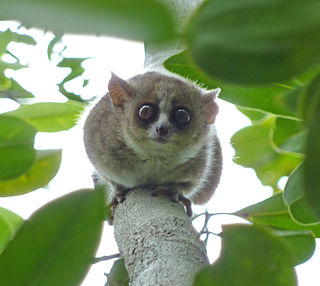
Lemurs, primates belonging to the suborder Strepsirrhini which branched off from other primates less than 63 million years ago, evolved on the island of Madagascar, for at least 40 million years. They share some traits with the most basal primates, and thus are often confused as being ancestral to modern monkeys, apes, and humans. Instead, they merely resemble ancestral primates.
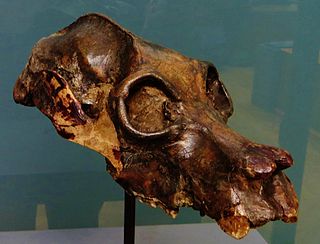
Subfossil lemurs are lemurs from Madagascar that are represented by recent (subfossil) remains dating from nearly 26,000 years ago to approximately 560 years ago. They include both extant and extinct species, although the term more frequently refers to the extinct giant lemurs. The diversity of subfossil lemur communities was greater than that of present-day lemur communities, ranging to as high as 20 or more species per location, compared with 10 to 12 species today. Extinct species are estimated to have ranged in size from slightly over 10 kg (22 lb) to roughly 160 kg (350 lb). Even the subfossil remains of living species are larger and more robust than the skeletal remains of modern specimens. The subfossil sites found around most of the island demonstrate that most giant lemurs had wide distributions and that ranges of living species have contracted significantly since the arrival of humans.

Didierea madagascariensis, commonly known as the octopus tree, is a species of Didiereaceae endemic to the spiny thickets of southwestern Madagascar. It was first described scientifically by the French botanist Henri Ernest Baillon in 1880 and is the type species of the genus Didierea.

Lemurs were first classified in 1758 by Carl Linnaeus, and the taxonomy remains controversial today, with approximately 70 to 100 species and subspecies recognized, depending on how the term "species" is defined. Having undergone their own independent evolution on Madagascar, lemurs have diversified to fill many ecological niches normally filled by other types of mammals. They include the smallest primates in the world, and once included some of the largest. Since the arrival of humans approximately 2,000 years ago, lemurs have become restricted to 10% of the island, or approximately 60,000 square kilometers (23,000 sq mi), and many face extinction. Concerns over lemur conservation have affected lemur taxonomy, since distinct species receive increased conservation attention compared to subspecies.
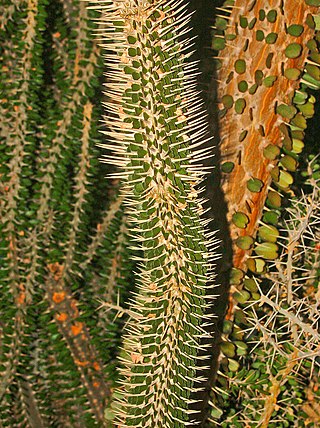
Alluaudia montagnacii is a rare species of flowering plant in the family Didiereaceae.
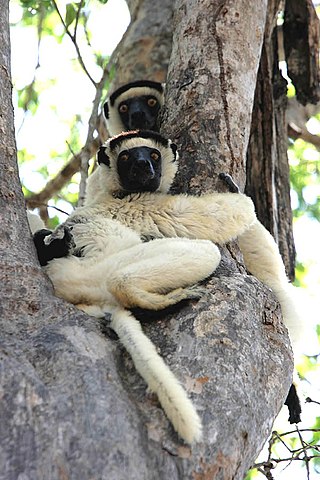
The Kirindy Forest is a private nature reserve situated in western Madagascar, about 50 km northeast of the town of Morondava, near Ambivy. The forest reserve falls within the boundaries of the Kirindy Mitea National Park, which spreads further to the south.

Didierea is a genus of succulent flowering plants in the family Didiereaceae. It is dedicated to naturalist Alfred Grandidier (1836-1921).

Alluaudia comosa is a rare species of flowering plant. It belongs to the family Didiereaceae, subfamily Didiereoideae, which is found only in the coastal area of SW Madagascar. Didierea comosa Drake is a synonym. It is listed as "vulnerable" on the IUCN Red List of Threatened Species.
Alluaudiopsis is a genus of shrubby flowering plants belonging to the family Didiereaceae. Species of Alluaudiopsis are dioecious, with male and female flowers on separate plants.























